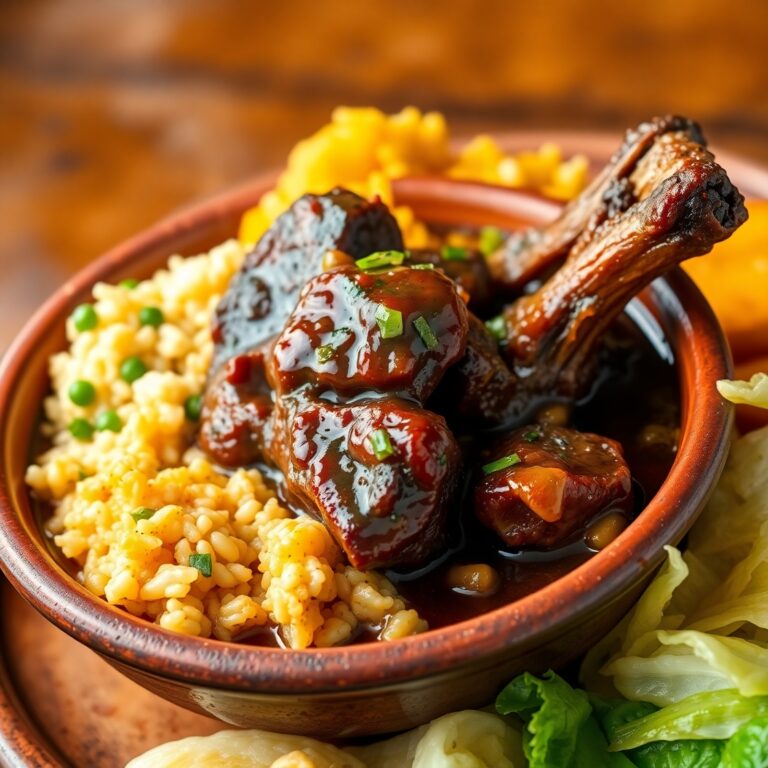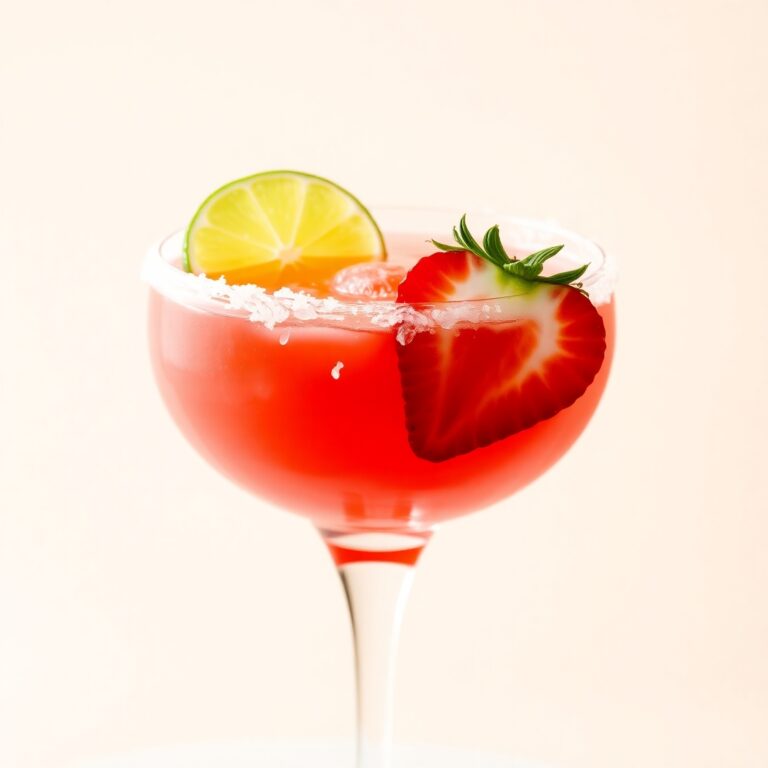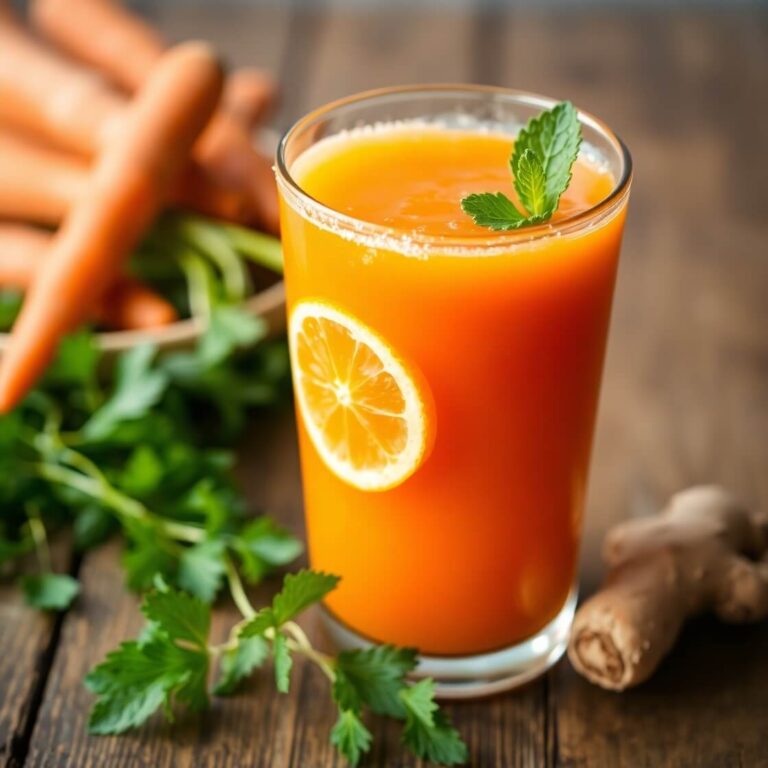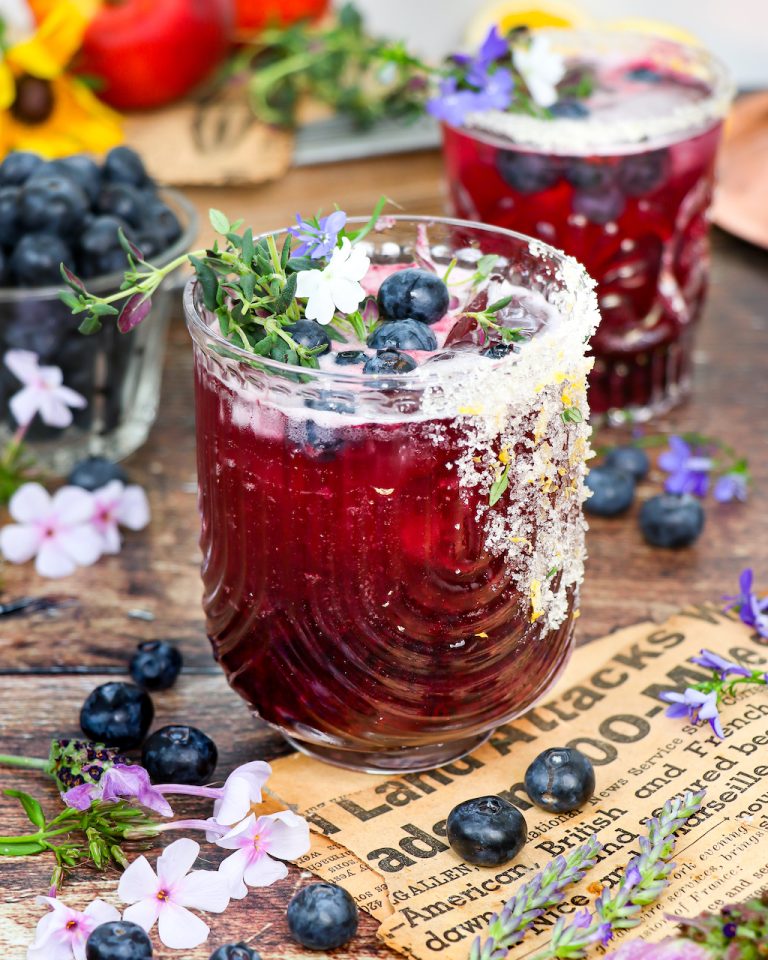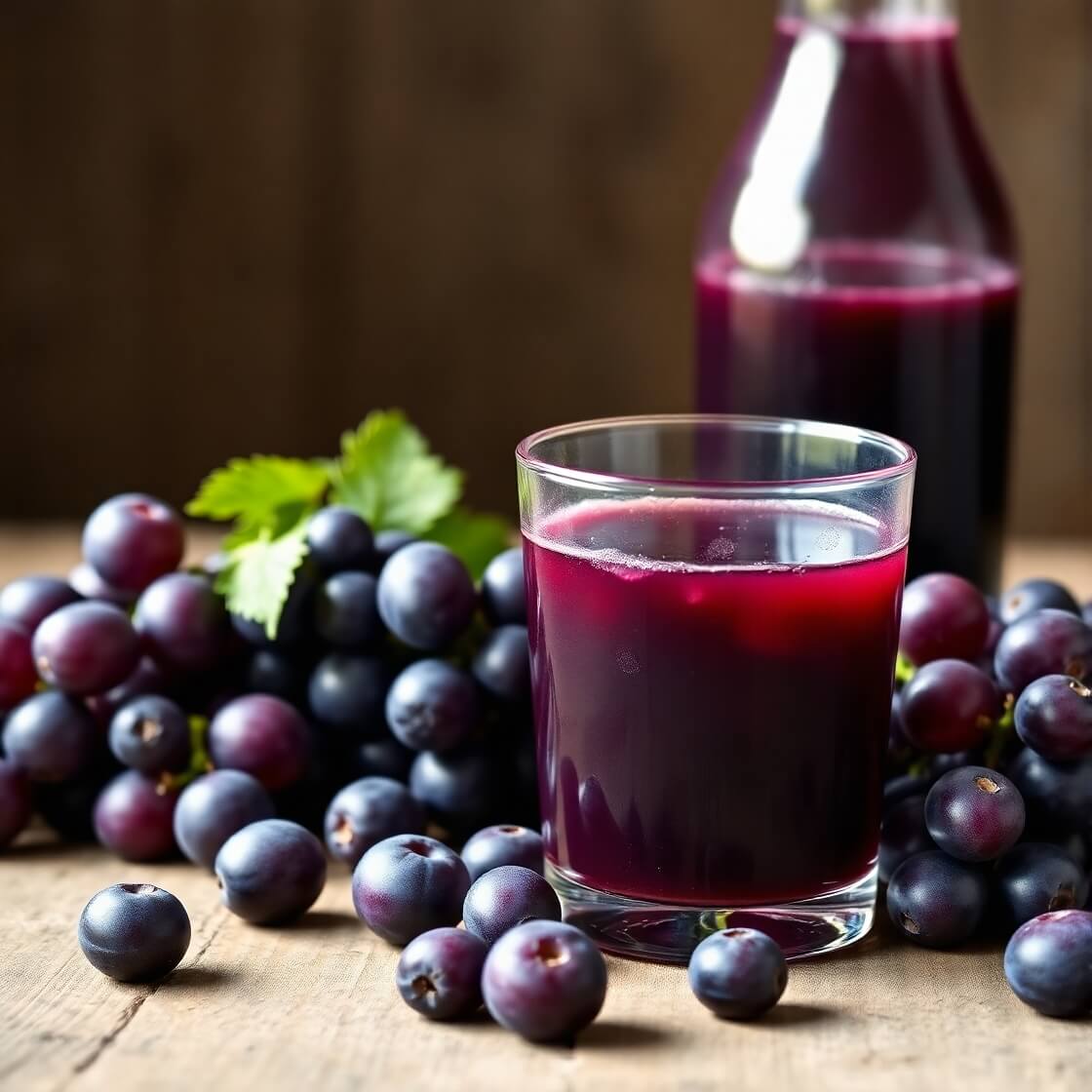
Grape juice is one of those simple pleasures that brings a nostalgic kind of comfort—deeply refreshing, naturally sweet, and bursting with the essence of fresh grapes.
I first made this recipe during late summer, when the farmers’ markets in our area were overflowing with Concord grapes. Their deep purple hue and heady aroma were impossible to resist. I wanted to preserve that seasonal flavor in its purest form, without additives or unnecessary sugar.
The beauty of homemade grape juice lies in its simplicity. You only need a few basic tools and some ripe grapes, but what you end up with is a luxurious, antioxidant-rich juice that far surpasses anything you’d buy from a store. If you’ve ever tasted grape juice made from scratch, you know it has a clarity of flavor that bottled versions just can’t match.
In this recipe guide, I’ll walk you through everything you need to make your own batch of fresh grape juice at home. It’s easier than you think, and deeply rewarding.
Why I Love This Recipe
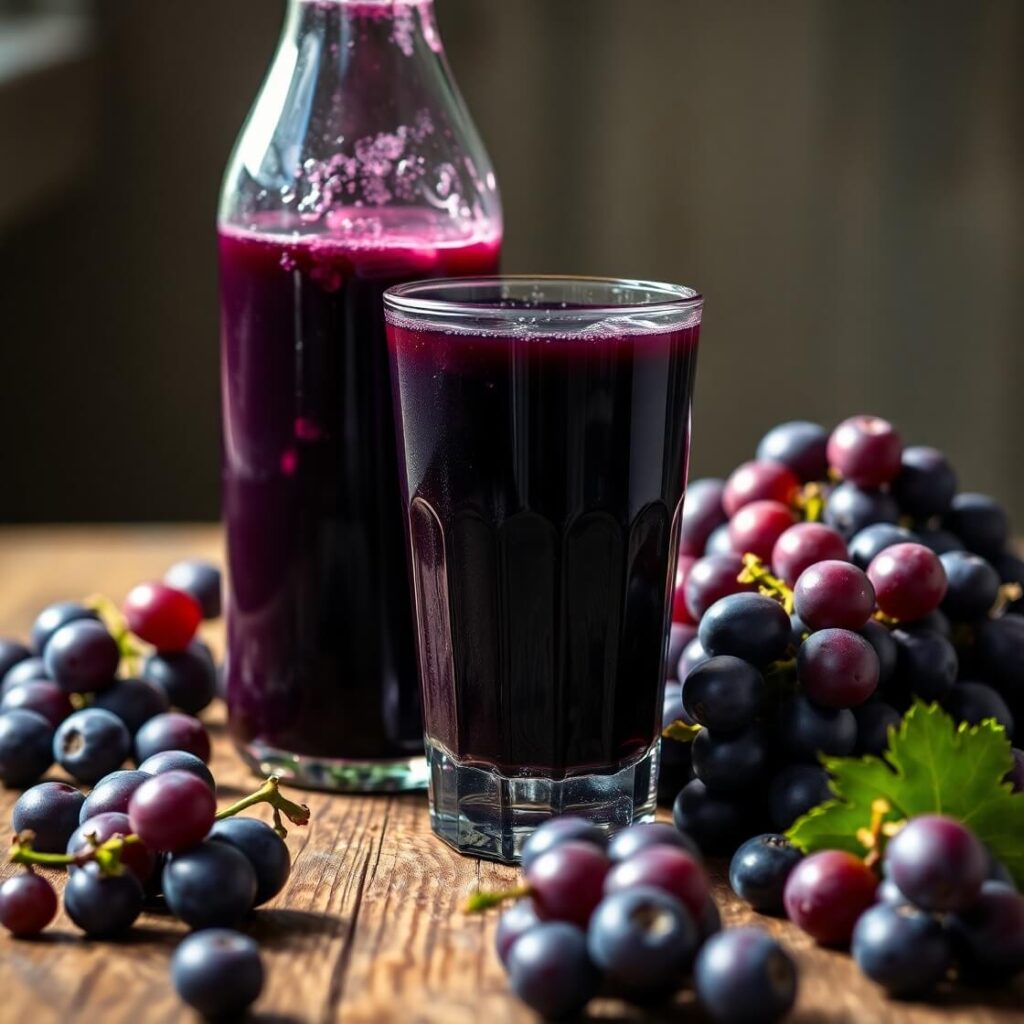
There’s something undeniably wholesome about making grape juice from scratch. This recipe isn’t just about getting a refreshing drink—it’s about taking something seasonal and turning it into something lasting.
The specialty of this recipe lies in its purity and versatility. No artificial colors. No preservatives. Just clean, natural grape flavor the way it’s meant to be.
And you’re in full control: whether you want it completely sugar-free, or just lightly sweetened, you can adjust it to your preference. That makes this recipe perfect for families, kids, or anyone trying to live a healthier lifestyle.
Homemade grape juice is also packed with natural antioxidants like resveratrol, especially when made with Concord or black grapes. Unlike commercially processed juices that undergo high-heat pasteurization (which often depletes nutrients), this recipe retains much more of the natural goodness of the grapes.
It’s not just a drink—it’s an experience of the season, and it tastes even better when shared.
Ingredients for Grape Juice
For this grape juice recipe, you only need a few basic ingredients—but the quality matters.
Here’s what you’ll need:
Fresh Grapes:
Choose fully ripened, seedless grapes—either Concord (for a tart and tangy purple juice) or red/green seedless table grapes for a milder flavor.
The grapes should be plump, sweet, and fragrant. Avoid underripe or overly mushy fruit.
Water:
Filtered water is ideal here, especially if your tap water has a strong flavor. This helps preserve the clean taste of the grapes.
Sweetener (Optional):
Depending on how sweet your grapes are, you may not need any added sugar. If you do, use a natural sweetener like honey, maple syrup, agave, or cane sugar. Start with a small amount—you can always add more.
Lemon Juice (Optional):
Just a splash of lemon juice adds brightness and helps preserve the juice for longer. It’s optional but recommended if you like a slightly tangy undertone.
That’s it. No preservatives, no artificial additives, and no fuss.
How Much Time Will You Need?
Homemade grape juice is surprisingly quick to make, especially in small batches.
Here’s a breakdown of the time you’ll need:
- Prep time: 10 minutes (for washing and removing stems)
- Cook time: 15–20 minutes (simmering the grapes)
- Straining and cooling: 20–30 minutes (depending on method)
- Total time: About 45 minutes to 1 hour
If you’re making a larger batch or planning to can the juice, add another 30–60 minutes.
How to Make This Grape Juice
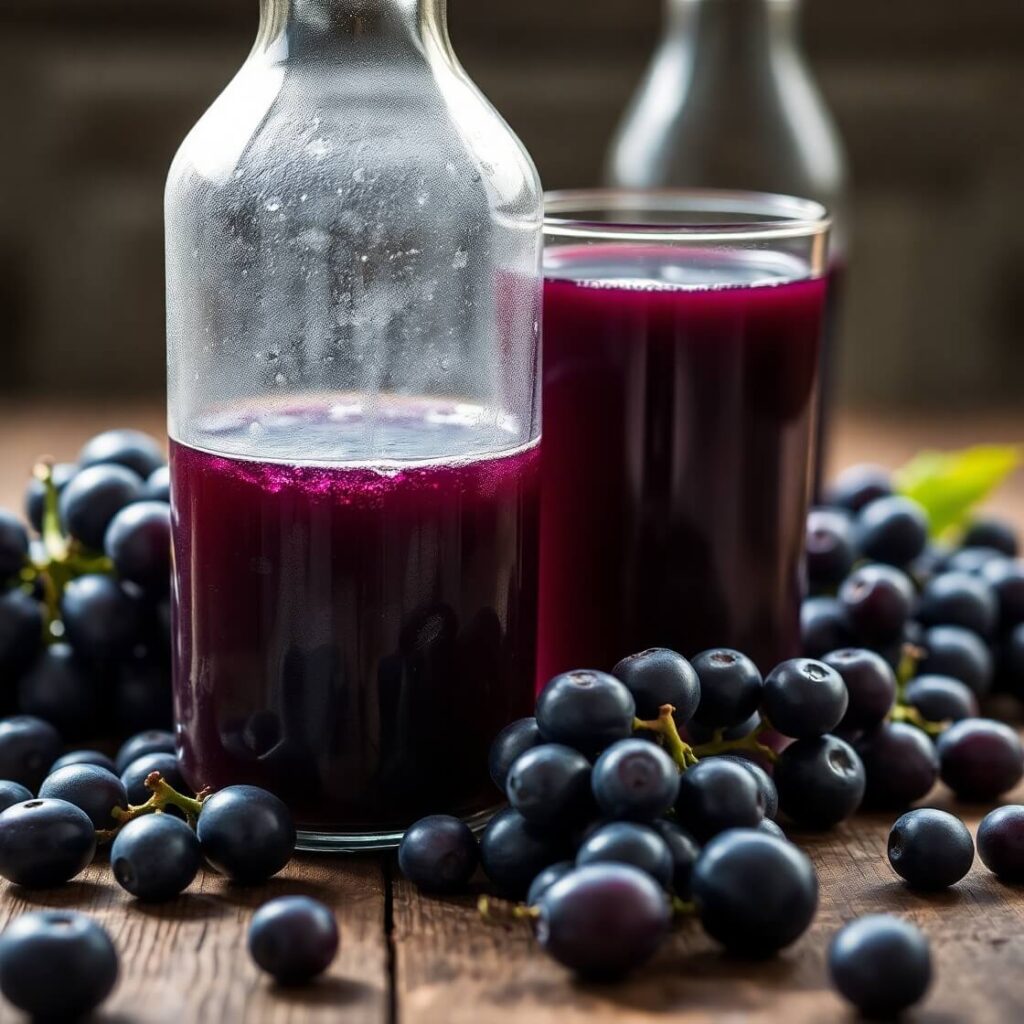
Here’s the step-by-step process to make fresh, delicious grape juice from scratch:
Step – 1: Wash and De-stem the Grapes
Start by rinsing your grapes thoroughly under cold running water. This helps remove any dirt, pesticides, or residue.
Pick the grapes off their stems and discard any damaged or underripe ones.
Place the clean grapes in a large colander or bowl.
Step – 2: Simmer the Grapes
Transfer the grapes into a large stockpot or heavy-bottomed saucepan.
For every 4 cups of grapes, add about ½ cup of water—this helps get things started without scorching the bottom.
Turn the heat to medium and cover the pot. As the grapes heat up, they’ll release juice naturally.
Use a potato masher or wooden spoon to gently mash the grapes every few minutes to release more juice.
Simmer the mixture for 10–15 minutes, stirring occasionally, until the grapes are soft and their skins have broken down.
Step – 3: Strain the Juice
Once the grapes are fully cooked, remove the pot from heat.
Place a fine mesh sieve or cheesecloth over a large bowl or pitcher. Slowly pour the grape mixture into the strainer, letting the juice drip through naturally.
Use the back of a spoon to press the solids and extract as much juice as possible. For a super clear juice, you can strain it a second time through cheesecloth.
Discard the pulp or save it to make grape jelly or compost.
Step – 4: Taste and Adjust
Let the juice cool slightly, then give it a taste. If it’s tart, stir in a little sweetener (start with 1–2 tablespoons per quart and adjust to taste).
Add a teaspoon of lemon juice if you’d like to brighten the flavor.
Step – 5: Chill or Bottle
Transfer the juice into glass jars or bottles. Let it cool completely before refrigerating.
The juice will stay fresh in the fridge for up to 5–7 days. You can also freeze it in airtight containers for up to 6 months.
Substitutions
Depending on your dietary preferences or what you have on hand, here are a few ingredient swaps that work well:
Instead of Concord Grapes:
Use red or green seedless grapes. Red grapes are sweeter and milder, while green grapes yield a brighter, more tart juice.
Instead of Sugar:
Try honey, agave nectar, coconut sugar, or stevia. These offer natural sweetness and are easier to digest for some people.
No Lemon Juice?
You can use a small splash of apple cider vinegar for acidity, or leave it out if your juice tastes balanced on its own.
Water-Free Option:
Skip the added water if your grapes are extra juicy and ripe. This yields a more concentrated flavor and thicker texture.
Best Side Dishes for Grape Juice
Homemade grape juice is delicious on its own, but here are three perfect pairings to elevate the experience:
1. Cheese and Cracker Platter
Aged cheeses like gouda or cheddar pair beautifully with the fruity sweetness of grape juice. Add some roasted nuts for texture.
2. Fresh Fruit Salad
A light fruit salad with melon, kiwi, and berries enhances the fresh, natural vibe of the juice.
3. Grilled Chicken Wraps
If you’re serving juice at brunch or lunch, a light grilled chicken wrap makes the meal more satisfying without overpowering the delicate juice.
Serving and Presentation Tips
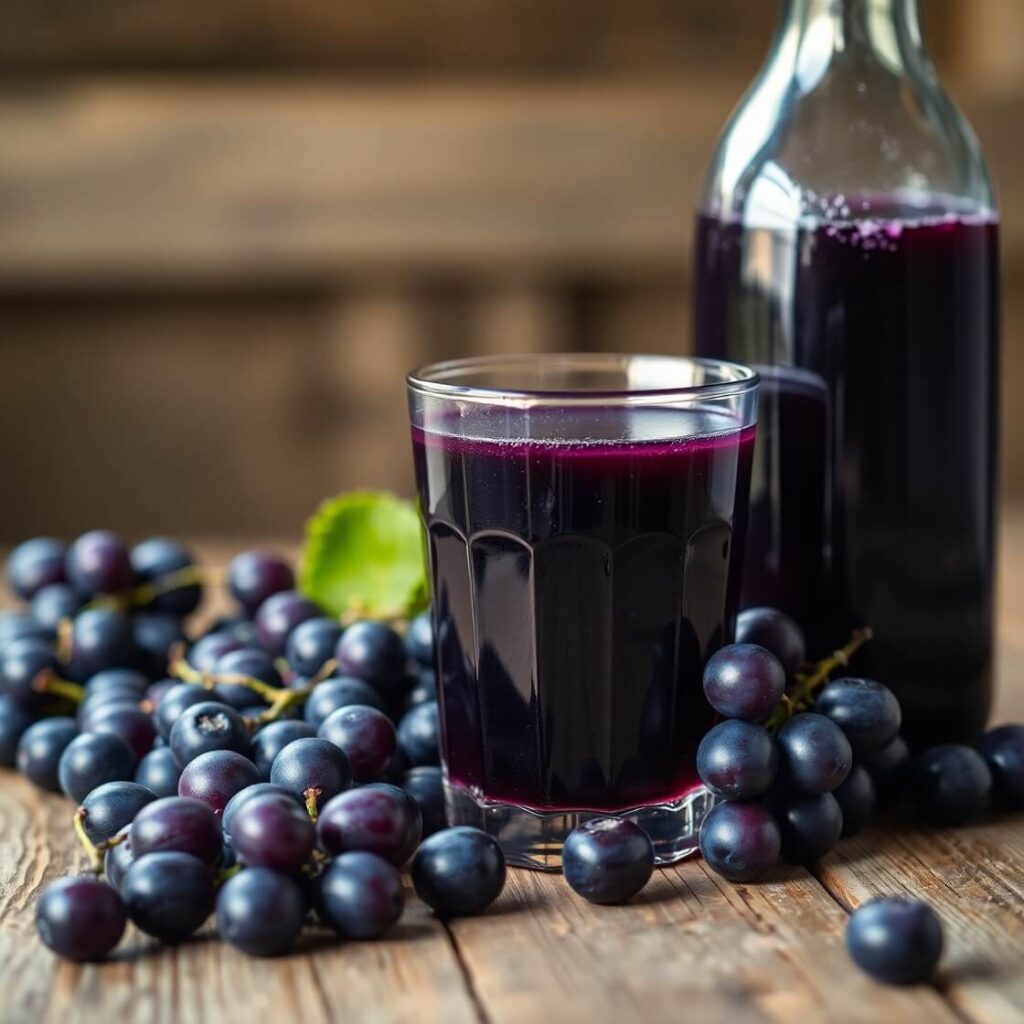
Presentation plays a subtle but powerful role in elevating the experience of homemade grape juice. While the drink itself is naturally beautiful with its rich, jewel-toned hue, a few thoughtful touches can make it feel truly special.
Serve chilled—grape juice is best enjoyed cold, straight from the refrigerator. Use clear glass pitchers to highlight the color, and serve in short tumblers or stemless wine glasses to give it an elegant feel.
For gatherings, you can dress it up with:
- A few frozen grapes in each glass (they act like ice cubes without diluting the juice).
- A sprig of fresh mint or a thin lemon slice on the rim.
- Edible flowers or crushed ice in tall glasses for summer brunches.
If you’re serving it alongside food, try offering a small cheese plate or breakfast pastries to create a balanced spread.
Tips and Tricks to Make This Recipe Even Better
Want that store-quality taste with none of the preservatives? These tricks will make your homemade grape juice smooth, vibrant, and full of flavor.
- Use fully ripened grapes. The riper the grapes, the richer the flavor. Underripe grapes can make the juice sour and flat.
- Macerate before heating. Let the grapes sit after mashing them to release even more juice naturally before simmering.
- Double strain for clarity. If you prefer a clear juice, pass it through a fine mesh sieve first and then again through cheesecloth. This removes any sediment or foam.
- Don’t overcook the grapes. Over-simmering breaks down the fruit too much and can give your juice a dull, cooked flavor.
- Add a hint of spice. For a warming variation, simmer the grapes with a pinch of cinnamon or a few cloves for a spiced grape cider twist.
Common Mistakes to Avoid
Even with a simple recipe like this, a few small missteps can impact flavor and texture. Here’s what to watch out for:
- Using underripe or sour grapes. This results in a bitter or flat-tasting juice that may require heavy sweetening.
- Skipping the straining step. Leaving solids in the juice leads to an unrefined texture and shorter shelf life.
- Boiling the grapes at high heat. Gentle simmering is key—boiling can scorch the fruit and give your juice a cooked, unpleasant note.
- Adding too much sweetener too soon. Always taste first. The natural sugar content of grapes varies, and you may not need extra sugar at all.
- Storing in plastic containers. Always store in glass jars or bottles. Plastic can retain odors and affect the taste of your juice.
How to Store It
Homemade grape juice doesn’t contain preservatives, so proper storage is essential.
Short-Term (Refrigeration):
- Store in clean, sterilized glass jars or bottles with tight-fitting lids.
- Keep refrigerated at all times.
- Best consumed within 5–7 days.
Long-Term (Freezing):
- Freeze in freezer-safe glass jars or BPA-free plastic containers.
- Leave 1 inch of headspace to allow for expansion.
- Frozen juice keeps well for up to 6 months.
Canning Option:
If you have experience with water bath canning, you can also preserve the juice for shelf stability. Process it in sterilized canning jars with proper technique for long-term storage (up to 1 year unopened).
FAQ
Q1: Can I make grape juice without cooking the grapes?
Yes. You can cold-press grapes using a juicer or food mill for raw juice. However, it will be less shelf-stable and should be consumed within 2–3 days.
Q2: Can I use green grapes for this recipe?
Absolutely. Green grapes yield a lighter, crisper juice. They’re typically sweeter, so you may not need to add sweetener.
Q3: Is this juice suitable for kids and toddlers?
Yes, especially when made without added sugar. Just strain well to remove all pulp and seeds.
Q4: Can I make this in a slow cooker?
Yes. Add the grapes and a splash of water to a slow cooker and cook on low for 4–5 hours. Then strain as usual.
Q5: What can I do with the leftover grape pulp?
Use it to make jelly, mix into smoothies, or compost it. It’s full of fiber and natural sweetness.
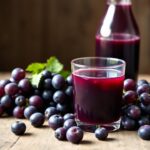
Grape Juice Recipe
- Total Time: 45 minutes
- Yield: 6 cups
- Diet: Vegetarian
Description
A clean, naturally sweet, and antioxidant-rich homemade grape juice that captures the true essence of fresh grapes. This recipe is simple, quick, and requires no artificial preservatives—just the real taste of seasonal fruit. Whether you serve it chilled over ice, freeze it for later, or use it in recipes, it’s a refreshing treat the whole family will love.
Ingredients
- 8 cups fresh, ripe seedless grapes (Concord or red/green)
- 1 cup filtered water
- 1–2 tablespoons honey or sugar (optional)
- 1 tablespoon lemon juice (optional)
Instructions
- Wash and de-stem grapes thoroughly. Discard any damaged ones.
- Place grapes in a large pot with water. Simmer over medium heat for 15 minutes, gently mashing with a spoon as they soften.
- Once grapes have broken down and released juice, remove from heat.
- Strain mixture through a fine mesh sieve or cheesecloth into a bowl.
- Taste and adjust sweetness. Stir in lemon juice if desired.
- Cool slightly, then transfer juice to clean glass bottles or jars.
- Refrigerate and enjoy within a week.
Notes
Concord grapes offer the boldest flavor.
Skip sweetener if your grapes are naturally sweet.
For longer storage, freeze juice in airtight containers.
For clearer juice, strain a second time using cheesecloth.
- Prep Time: 10 minutes
- Cook Time: 15 minutes
- Category: Beverages
- Method: Simmering and Straining
- Cuisine: American
Nutrition
- Serving Size: 6 cups
- Calories: 120


